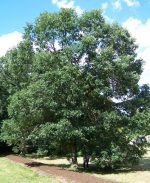
Growing up to 90’ tall, this deciduous tree is native to moist areas in bottomlands and lowland such as riparian soils and the edges of swamps from Massachusetts to Wisconsin, south to Virginia and Missouri. It is a member of the beech family, Fagaceae, that also includes chestnut. The trees have brown to grey to brown bark depending on maturity. The bark becomes scaly and furrowed and may begin to peel with age. The glossy green leaves are 3-9″ long, lobed, and have toothed margins and hairy light green or white undersides. In the fall they turn brown to yellow or red. In spring, elongated pendant cluster of inconspicuous yellow-green male flowers and green to red female flowers emerge on the same tree. The fertilized female flowers give way to shiny brown acorns that are 1/2 to 3/4″ long with a cap that encloses 1/3-1/2 the acorn. The acorns mature in 1-2 years and provide food for a variety of wildlife including birds, small mammals, deer, and bear. The genus name, Quercus, is the classical Latin name for oak trees. The specific epithet, bicolor, comes from the Latin words bis meaning twice and the color, meaning pigment, tint, shade, and refers to the difference in appearance of the two sides of the leaves.
Type: Deciduous tree
Outstanding Feature: Tolerance to wet soil
Form: Rounded, spreading
Growth Rate: Moderate
Bloom: Catkins of male and female flowers on the same tree in spring
Size: 50-90′ H x 30-100′ W
Light: Full sun
Soil: Average, medium to wet, acidic
Hardiness: Zones 3-8
Care: Low maintenance
Pests and Diseases: Anthracnose, canker, leaf spot rust, blight, galls, oak wilt, caterpillars, borers, leaf miners, oak lace bug, oak mite
Propagation: Seed
Photo Credit: Wikipedia